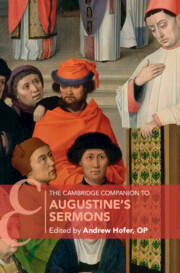Refine search
Actions for selected content:
154 results
2 - Spies, Masons, and “Purely Communist”
-
- Book:
- In the Shadow of the Vatican
- Published online:
- 23 October 2025
- Print publication:
- 06 November 2025, pp 60-90
-
- Chapter
- Export citation
8 - Church School Legacies for Citizenship
- from Part IV - Extensions and Implications
-
- Book:
- Faith in Democracy
- Published online:
- 23 October 2025
- Print publication:
- 06 November 2025, pp 201-232
-
- Chapter
- Export citation
2 - Liberal Democracy as an Institutional Guarantee of Church Interests
- from Part I - Theory
-
- Book:
- Faith in Democracy
- Published online:
- 23 October 2025
- Print publication:
- 06 November 2025, pp 29-45
-
- Chapter
- Export citation
6 - Church Activism and Support for Liberal Democratic Institutions
- from Part III - Testing Underlying Assumptions
-
- Book:
- Faith in Democracy
- Published online:
- 23 October 2025
- Print publication:
- 06 November 2025, pp 121-156
-
- Chapter
- Export citation
3 - The Politics of Church Education in Sub-Saharan Africa
- from Part I - Theory
-
- Book:
- Faith in Democracy
- Published online:
- 23 October 2025
- Print publication:
- 06 November 2025, pp 46-70
-
- Chapter
- Export citation
9 - Reconsidering Churches, Education, and Democracy in the Contemporary World
- from Part IV - Extensions and Implications
-
- Book:
- Faith in Democracy
- Published online:
- 23 October 2025
- Print publication:
- 06 November 2025, pp 233-244
-
- Chapter
- Export citation
1 - Church Interests in Liberal Democracy
- from Part I - Theory
-
- Book:
- Faith in Democracy
- Published online:
- 23 October 2025
- Print publication:
- 06 November 2025, pp 3-28
-
- Chapter
- Export citation

Faith in Democracy
- The Logic of Church Advocacy for Liberal Democratic Institutions in Africa
-
- Published online:
- 23 October 2025
- Print publication:
- 06 November 2025
5 - Instrumental Agency and Ecclesiastical Unity
-
- Book:
- God, Slavery, and Early Christianity
- Published online:
- 19 September 2025
- Print publication:
- 09 October 2025, pp 200-256
-
- Chapter
- Export citation
Conclusion
-
- Book:
- God, Slavery, and Early Christianity
- Published online:
- 19 September 2025
- Print publication:
- 09 October 2025, pp 257-270
-
- Chapter
- Export citation

The Cambridge Companion to Christian Liturgy
-
- Published online:
- 19 September 2025
- Print publication:
- 09 October 2025
7 - Theological Benefits of the Instrumental Doctrine
- from Part III - Theological Implications
-
- Book:
- The Humanity of Christ as Instrument of Salvation
- Published online:
- 21 August 2025
- Print publication:
- 04 September 2025, pp 201-225
-
- Chapter
- Export citation
Introduction
-
- Book:
- The Humanity of Christ as Instrument of Salvation
- Published online:
- 21 August 2025
- Print publication:
- 04 September 2025, pp 1-12
-
- Chapter
- Export citation
Introduction
-
-
- Book:
- The Cambridge Companion to Christian Heresy
- Published online:
- 17 July 2025
- Print publication:
- 31 July 2025, pp 1-14
-
- Chapter
- Export citation
Credo ut Intelligam: Anselm on Believing in the Church
-
- Journal:
- New Blackfriars ,
- Published online by Cambridge University Press:
- 28 July 2025, pp. 1-11
-
- Article
- Export citation
11 - Preaching on the Totus Christus
- from Part III - Augustine’s Preaching Themes
-
-
- Book:
- The Cambridge Companion to Augustine's Sermons
- Published online:
- 26 May 2025
- Print publication:
- 12 June 2025, pp 209-225
-
- Chapter
- Export citation
4 - Sermons on the Old Testament
- from Part II - Augustine’s Sermons on the Scriptures and Liturgical Feasts
-
-
- Book:
- The Cambridge Companion to Augustine's Sermons
- Published online:
- 26 May 2025
- Print publication:
- 12 June 2025, pp 81-97
-
- Chapter
- Export citation
1 - Augustine as Preacher and His Brethren in the Church
- from Part I - Augustine’s Pastoral Task of Preaching Sermons
-
-
- Book:
- The Cambridge Companion to Augustine's Sermons
- Published online:
- 26 May 2025
- Print publication:
- 12 June 2025, pp 25-43
-
- Chapter
- Export citation
17 - Cyprian of Carthage, On the Oneness of the Catholic Church (Second Edition)
- from Part III - Imagining the Community
-
-
- Book:
- The Cambridge Edition of Early Christian Writings
- Published online:
- 19 May 2025
- Print publication:
- 12 June 2025, pp 322-342
-
- Chapter
- Export citation

The Cambridge Companion to Augustine's Sermons
-
- Published online:
- 26 May 2025
- Print publication:
- 12 June 2025
